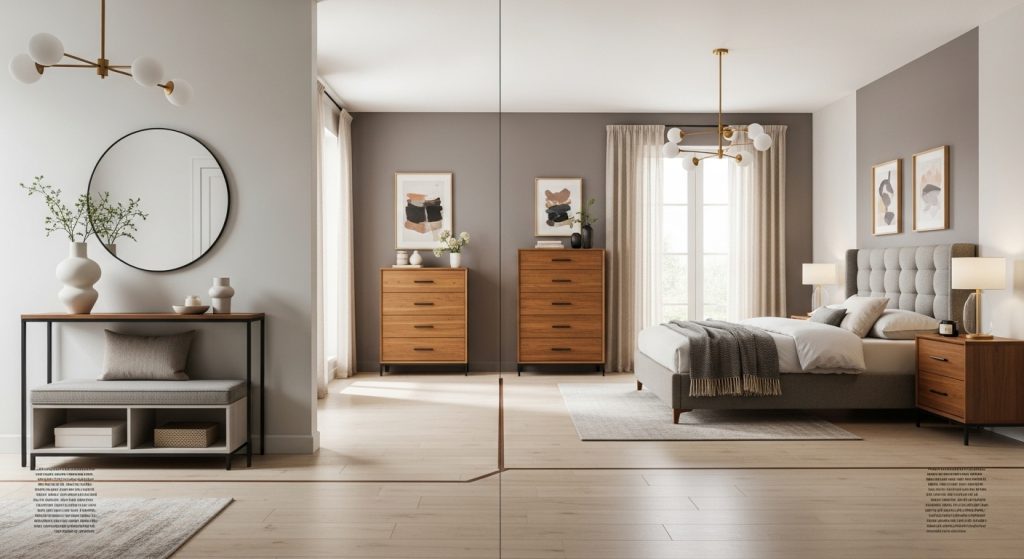Learning how to keep entryway and bedroom furniture cohesive is a fundamental aspect of professional interior styling tips that elevates a house into a truly unified home. The entryway sets the first impression, while the bedroom is a personal sanctuary. Creating a seamless visual connection between these spaces, even if they are not directly adjacent, fosters a sense of harmony, intention, and sophisticated design flow.

This definitive home design guide provides an expert framework. It explores the core principles of furniture coordination across rooms, offers practical matching furniture ideas and strategies, and details how to use color, material, and style consistently. This ensures your home tells a single, beautiful story from the threshold to the most private retreat.
What Defines Cohesion Between Entryway and Bedroom Furniture?
Cohesion between entryway and bedroom furniture is defined by a shared visual language. This is achieved through the consistent and intentional use of related styles, color palettes, materials, finishes, or motifs across both spaces, creating a harmonious flow and a sense of belonging within the same home.
This shared language does not require identical furniture but rather a clear connection. It is about establishing a design narrative that begins in the entryway and continues logically into the private spaces. This creates a feeling of calm and order, making the entire home feel more resolved and thoughtfully designed. A lack of cohesion can make the transition between rooms feel abrupt or disjointed, undermining the overall aesthetic.
Why Does This Connection Matter Aesthetically?
This connection matters aesthetically because it creates a sense of visual flow and harmony. When key design elements are repeated or complemented across different rooms, the eye travels smoothly through the space. This creates a more restful and sophisticated experience. A cohesive design feels intentional and well-curated. It signals a higher level of attention to detail compared to a home where each room feels like an isolated, unrelated entity.
How Does it Impact the Home’s Overall Feeling?
Cohesion impacts the home’s overall feeling by fostering a sense of calm and predictability. Knowing that a consistent design language exists throughout the home creates a subconscious feeling of order and tranquility. The entryway sets an expectation, and the bedroom fulfills it, reinforcing the home’s established style and mood. This consistency contributes significantly to a feeling of sanctuary and well-being. The impact of a cohesive environment on comfort is a key principle in interior design psychology.
How Does Defining an Overall Home Style Create Consistency?
Defining an overall home style is the crucial first step. This overarching aesthetic serves as the guiding principle for all furniture and decor choices, ensuring consistency between the entryway, bedroom, and all other connecting spaces. Whether choosing modern, traditional, farmhouse, or eclectic, having a clear vision prevents a disjointed mix.
This overarching style acts as a filter. It helps narrow down choices and ensures that individual pieces, even if purchased at different times, contribute to a unified narrative. It is the foundation upon which all successful furniture coordination is built.
Why is a Guiding Aesthetic Necessary?
A guiding aesthetic is necessary because it provides direction and parameters. Without a defined style, furniture choices can become random and based on fleeting preferences, leading to a home that lacks identity. A clear style direction (e.g., “Organic Modern,” “Classic Traditional”) informs decisions about furniture silhouettes, materials, colors, and textures, ensuring they work together harmoniously across different rooms. This principle is explored further in our guide to interior styling furniture coordination.
How Does This Style Inform Both Entryway and Bedroom Choices?
The chosen style directly informs furniture choices in both key areas.
- Entryway: If the style is Modern Farmhouse, the entryway might feature a rustic wood Console table with black metal accents.
- Bedroom: This style would then translate to the bedroom with perhaps a simple wooden bed frame, nightstands with a similar rustic finish or black hardware, and natural linen bedding. The specific pieces differ, but the underlying style language remains consistent.
How to Maintain Style Consistency Without Being Rigid?
Maintaining style consistency does not mean every piece must rigidly adhere to a single definition. It is about ensuring the dominant pieces in each room belong to the same style family. Accent pieces can introduce subtle variations or contrasts, but the core aesthetic should remain clear. For example, a predominantly modern home might incorporate a few carefully chosen vintage accent chairs, but the main sofa, bed, and tables would maintain clean, modern lines.
What Role Does Color Palette Play in Connecting Spaces?
A consistent color palette is one of the most powerful and effective tools for creating cohesion between the entryway and the bedroom. Using related colors across these spaces creates an immediate and obvious visual link, guiding the eye and establishing a sense of flow.
Repeating colors provides a subconscious thread of connection. Even if the furniture styles or materials differ slightly, a shared color palette can make the spaces feel intentionally linked and harmonious.
Why Establish a Whole-Home Color Palette?
Establishing a whole-home color palette provides a roadmap for all decor decisions. This typically involves selecting:
- A Primary Neutral: Used for the majority of wall space and potentially large furniture pieces.
- A Secondary Neutral: A complementary neutral used for contrast or depth.
- One to Three Accent Colors: Used more sparingly in accessories, textiles, and artwork throughout the home. Having this defined palette ensures that color choices in different rooms relate to each other.
How to Repeat Key Colors in Both Areas?
Repeat your chosen palette colors strategically in both the entryway and the bedroom.
- Entryway: The wall color might be your primary neutral. An accent color could appear in artwork above the console table or a decorative bowl.
- Bedroom: The same primary neutral could be used on the walls. The secondary neutral might appear in the bedding. The accent color(s) could be repeated in throw pillows, lampshades, or artwork. This repetition creates a clear visual connection.
How Do Neutrals Provide a Unifying Base?
Using the same or closely related neutral colors for the walls and potentially large furniture pieces in both the entryway and bedroom provides a strong unifying base. Whites, grays, beiges, or creams create a calm, continuous backdrop. This allows furniture pieces with different wood tones or styles to coexist more harmoniously. The neutral base becomes the common ground upon which variations can be layered. Our guide on how to blend wood console tables with neutral color palettes emphasizes this technique.
How to Use Accent Colors as a Connecting Thread?
Use your chosen accent colors as deliberate connecting threads. A vibrant blue used in entryway art could reappear as the color of bedside lamps in the bedroom. A warm terracotta cushion on an entryway bench could be echoed in a pattern on the bedroom rug. These small but intentional pops of the same accent color create a subtle yet effective link between the spaces. The strategic use of accent colors is a key professional styling technique.
How Can You Coordinate Furniture Styles Without Matching Exactly?
Coordinating furniture styles between the entryway and bedroom does not require purchasing matching sets. In fact, a more sophisticated look is often achieved by selecting pieces that are stylistically compatible but not identical. The key is to find shared design elements or a common aesthetic language.
Achieving this curated blend requires a discerning eye. It involves identifying the core characteristics of each piece and ensuring they relate harmoniously.
Beyond Matching Sets: Finding Compatible Styles
Look for furniture pieces that belong to the same broad style category or share similar design DNA, even if they are not from the same collection.
- Modern: Look for clean lines, simple geometric forms, and minimal ornamentation in both entryway consoles and bedroom nightstands/dressers.
- Traditional: Pieces might share classic silhouettes, elegant curves, and perhaps similar decorative details like turned legs or specific hardware styles.
- Farmhouse/Rustic: Emphasize natural wood tones, distressed finishes, simple sturdy construction, and perhaps shared elements like X-braces or barn door hardware. The overall feeling or era should be consistent.
How to Identify Shared Design Elements?
Look for shared design elements that can create a visual link:
- Leg Style: Both the console and nightstands might feature similar tapered legs or straight block legs.
- Overall Form: Pieces might share a similar level of visual weight (e.g., both light and airy, or both substantial and grounded).
- Level of Detail: Both spaces might feature furniture with a similar degree of ornamentation (or lack thereof). These subtle similarities create a sense of belonging.
How Does the Transition Space Influence Choices?
Consider the transition space – the hallway or area connecting the entryway and bedroom. Furniture or decor within this connecting space should ideally blend elements from both areas, acting as a visual bridge. If furniture is visible from both the entryway and the bedroom doorway, ensure its style is compatible with both. Planning layout for flow is crucial, as discussed in small home furniture layout tips to maximize flow.
How Do You Harmonize Wood Tones and Finishes Across Rooms?
Harmonizing wood tones and finishes is one of the most effective strategies for how to keep entryway and bedroom furniture cohesive. Wood is often a significant material in both spaces. Ensuring the different wood pieces relate well to each other creates a strong sense of unity.
Creating this harmony requires understanding wood undertones and applying strategies like establishing dominance and ensuring repetition. It is about creating a curated wood palette for your home.
Why is Consistency in Wood Undertones Important?
Consistency in wood undertones (warm vs. cool) is generally the easiest way to ensure harmony. Pairing woods that share the same underlying warmth (like oak and cherry) or coolness (like ash and gray-washed pine) creates a naturally cohesive feel, even if the primary colors differ. Our guide on mixing wood tones between console tables and nightstands provides detailed examples of matching undertones.
How to Establish a Dominant Wood Finish?
Establish one wood finish as the dominant tone throughout the connected spaces. This might be dictated by your flooring or the largest furniture pieces. Use this dominant wood for key items like the entryway console or the main bedroom furniture (bed frame, dresser). Use other compatible wood tones as secondary accents. This hierarchy prevents a chaotic mix of too many competing woods.
How Can Architectural Elements Act as a Bridge?
Architectural elements can act as a bridge between different wood furniture pieces. If your home has consistent wood trim, interior doors, or flooring throughout the entryway, hallway, and bedroom, this provides a strong unifying element. The furniture woods should then relate harmoniously to these fixed architectural finishes. This is a core part of choosing the right finishes for consistent home decor.
What is the Unifying Power of Hardware Finishes?
Using the same metal finish for hardware across both entryway and bedroom furniture is a powerful unifying detail. If the console table has brushed brass pulls, using brushed brass on the nightstand lamps, drawer pulls, or even picture frames creates an instant, sophisticated connection. This works regardless of the wood tones used. Consistency in these small details has a large impact. The hardware market offers a vast array of finishes.
What is the Significance of Repeating Materials and Textures?
Repeating key materials and textures beyond just wood is another effective strategy for creating cohesion. This involves carrying certain tactile or visual elements from the entryway into the bedroom, creating a subtle but palpable link.
This textural thread adds another layer of sensory connection between the spaces. It makes the transition feel smoother and more natural.
How to Repeat Key Materials (Metal, Stone, Woven)?
Identify key materials used in one space and echo them in the other.
- Metal: If the entryway console has a black metal base, use black metal picture frames or a lamp base in the bedroom.
- Stone: A marble tray in the entryway could be echoed by marble coasters or a small marble object on the nightstand.
- Woven Textures: A seagrass basket under the entryway console could be complemented by a woven lampshade or storage basket in the bedroom.
How Can Textiles Create a Visual Link?
Textiles are powerful tools for creating visual links through color, pattern, and texture.
- Consistent Fabric Type: Using linen, for example, for entryway bench cushions and also for the bedroom curtains or throw pillows.
- Repeating Patterns: A subtle geometric pattern found in an entryway rug could reappear on a smaller scale in bedroom accent pillows.
- Shared Accent Colors: As mentioned, using the same accent color in textiles across both spaces is highly effective. The right textiles add softness and complete the cohesive narrative. The impact of textiles on ambiance is significant.
How Can Accessories and Decor Tie Everything Together?
Accessories and decor are the final layer where cohesion can be reinforced. These smaller elements provide opportunities to repeat colors, themes, or styles subtly, tying the entryway and bedroom together.
How Does Consistent Artwork Style or Framing Help?
Maintaining a consistent style of artwork (e.g., all abstract, all black and white photography) or using the same style and color of frames in both the entryway and bedroom creates a strong visual connection. This makes the art feel like part of a curated collection belonging to the same home.
What About Repeating Decor Motifs or Themes?
Repeating subtle motifs or themes can also create a link. If the entryway features decor with a subtle botanical theme (e.g., leaf-patterned tray, floral art), echoing this with a live plant or botanical prints in the bedroom reinforces the connection. The theme should be subtle to avoid feeling overly thematic.
How to Use Similar Decorative Objects?
Using similar types or styles of decorative objects in both spaces helps. If you use minimalist ceramic vases in the entryway, continue this aesthetic with similarly styled ceramics on the nightstands or dresser. If you favor brass objects in one space, incorporate a brass element in the other.
Conclusion
Learning how to keep entryway and bedroom furniture cohesive is about crafting a harmonious journey through your home. It is a process of intentional design that creates a seamless flow from the public face of your entryway to the private retreat of your bedroom. By defining an overall style, establishing a consistent color palette, thoughtfully coordinating furniture styles and finishes, repeating key materials and textures, and using accessories as connecting threads, you can achieve a truly unified and sophisticated interior. This approach transforms your house into a cohesive sanctuary, where every space feels connected and contributes to a beautiful, balanced whole.











